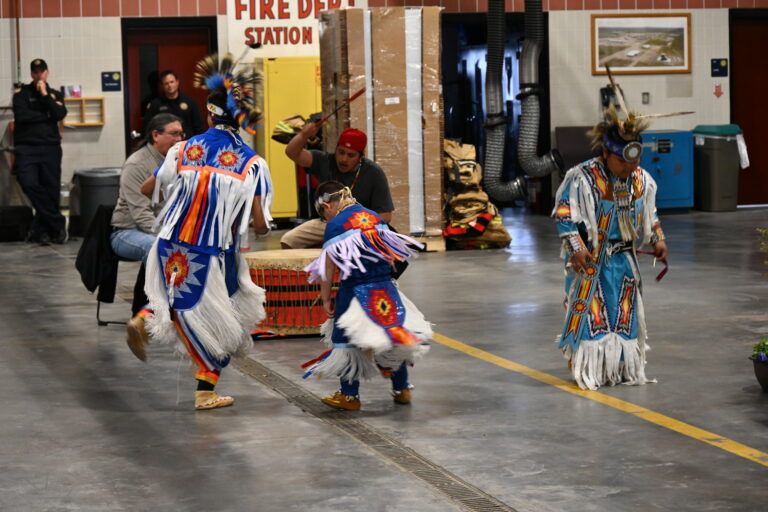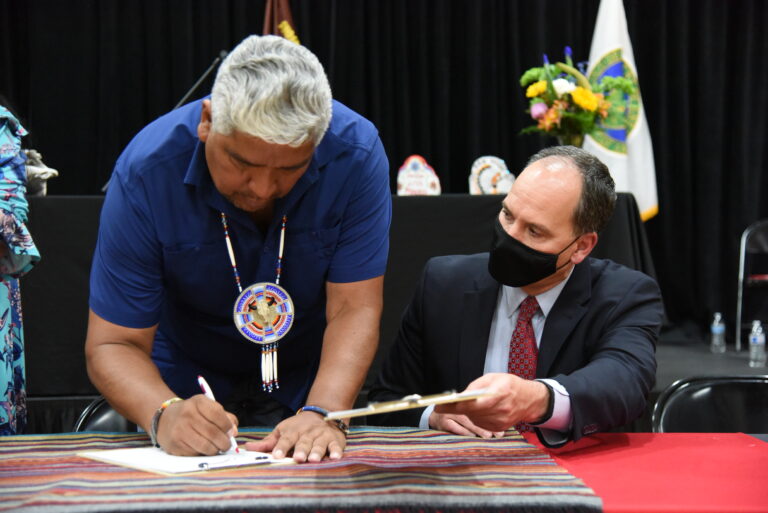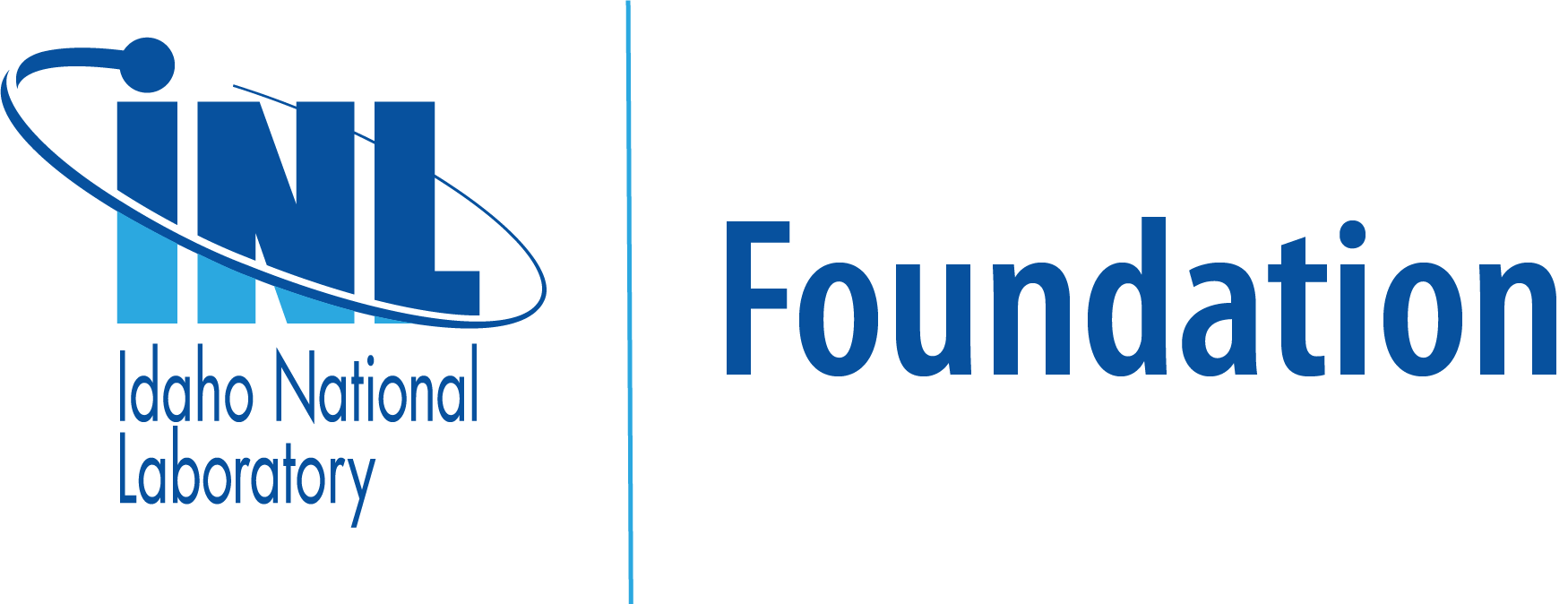Editor’s note: This story is partially adapted from a Tribal historical write-up titled “The Shoshone-Bannock Tribes.”
One story about the land where the Idaho National Laboratory Site now sits begins with a muskrat. In the “Legend of Creation” held by the Bannock Tribe, the area used to be “nothing but water.” As the story goes, the Father parted the foam on the water and called for the water people to come up to him. Beaver was the first of the water people to join Father. They talked and smoked, and then Father asked him to dive back in.
After waiting three days for Beaver to come back, Father repeated this process with Otter. But Otter also did not return. Finally, he called to Muskrat, the youngest of the water people. When Muskrat dove down, he went into the water “very straight and very deep.” On the third day, Father saw him floating, appearing to be dead. Crying, he took Muskrat into his hands.

Shoshone-Bannock dancers at INL’s Central Facilities Area.
While Father was holding Muskrat, Muskrat began to breathe. Father saw mud on his nose, and he took the mud and rolled it around and around in his hands. Using the mud, Father shaped mountains and valleys. He divided the waters and created rivers and oceans. From the mud of Muskrat’s nose, Father created the Earth on which we live today.
The Shoshone and Bannock people lived in Idaho as far back as 12,000-plus years ago, according to both tribal and archaeological accounts. The aboriginal lands of the Shoshone and Bannock people were much larger than the land where many of them live today, including parts of Canada and Mexico. Over time, they moved into extended family groups throughout present-day Idaho, known by the names of the areas where they lived or the food they ate.
Early days of the Shoshone and Bannock people
The Shoshone people are linguistically related to the Comanche people in the south, who helped them introduce horses into Idaho. The Bannocks are culturally similar to the Shoshone, with distinct language differences. They were related to the Paiutes who left the mountains of Oregon for the prairies of Idaho, where they also acquired horses and began to travel more.
Before fur trappers arrived in the 1810s, the areas occupied by the Shoshone-Bannock people teemed with wildlife species, including buffalo, mountain sheep, bears, deer, elk, moose, salmon, trout, rabbit, marmot and beaver. The arrival of fur trappers dramatically changed life for the Shoshone and Bannock people. In 1834, Nathaniel Wyeth founded the Fort Hall Trading Post, and this became a popular spot for white travelers on the Oregon and California trails. In 1843, a permanent white settlement was established in Bear River Valley, sending settlers flocking closer to Fort Hall.
The Fort Hall Reservation was established as part of the 1867 executive order that set up the Fort Bridger Treaty of July 3, 1868. The order called for 1.8 million acres of land on the reservation, but a survey error reduced that initial amount to 1.2 million acres. The original reservation was reduced further to make land available for white settlers and railroad construction. Currently, Fort Hall consists of only 544,000 acres. Because of their land acquisition program, 97% of the current Fort Hall land is tribal trust land.

Shoshone-Bannock students at Middle Butte Cave, an important cultural site on the INL desert.
The ancestors of the many bands of Shoshone and Bannock people were removed from their homelands in southwestern, southeastern and central Idaho, in addition to land outside of Idaho, to the Fort Hall Reservation. These included the many bands of Shoshone and Bannock people from the Salmon area, the Agai Deka, Boise Valley, Bruneau, Weiser, Yellowstone and Southwestern Montana. Today, their descendants return to their ancestral areas to hunt, fish, gather and visit areas of spiritual significance.
Idaho National Laboratory involvement
Since all INL campuses sit on the ancestral land of the Shoshone-Bannock people, the lab’s relationship with the Tribes is an important part of INL’s 75 years of history.
INL’s Cultural Resource Management Office has a dedicated team of archaeologists, historians and preservationists who help safeguard the history of this land, working closely with experts from the Cultural Resources/Heritage Tribal Office (CR/HeTO) of the Shoshone-Bannock Tribes and the Idaho State Historic Preservation Office. Additionally, INL researchers and the lab’s K-12 STEM Education team have partnered with the Tribes to build their workforce and advance the nation’s clean energy future.
Energy research
INL researchers, including members of the Tribes, have given presentations to Shoshone-Bannock students at Fort Hall on different energy resources, including hydropower.
The Tribes and INL, along with Pacific Northwest National Laboratory, are partners on an effort to upgrade the Fort Hall irrigation system. The study will help identify areas where modernizing the system could maximize benefits. The ongoing case study will include engagement meetings between technical tribal staff members and tribal policymakers.
“This partnership is very important for both the Tribes and INL,” said Cleve Davis, a geospatial data scientist with INL and a member of the Shoshone-Bannock Tribes. “Not only will it be an excellent opportunity to include a federally recognized Tribe for an irrigation modernization case study, but it will also strengthen the existing partnership between INL and the Tribes.”
Cultural resource management
Throughout INL’s history, cultural resources staff members at both INL and the Department of Energy (DOE) have collaborated with members of the Shoshone-Bannock Tribes’ Cultural Resources/Heritage Tribal Office, to manage the land and its cultural resources through an agreement in principle (AIP).

Shoshone-Bannock dancers at INL’s Central Facilities Area.
According to the agreement, DOE and the Tribes are committed to working together to address concerns regarding the environment, energy-related matters, educational opportunities, and natural and cultural resources issues. These issues are within the authority of and consistent with the laws and regulations by which DOE and the Tribes are governed. DOE acknowledges its trust responsibility to consult and work cooperatively with the Tribes, and to exercise statutory and legal authorities to protect tribal lands, assets, resources and treaty rights. Additionally, DOE strives to fulfill this responsibility through the agreement in principle, DOE American Indian and Alaska Native Tribal Government Policy, and other American Indian program initiatives.
Essentially, this agreement ensures that the Tribes have knowledge of Site operations, a voice in what’s happening there and how the land — particularly cultural and natural resources important to the Tribes, is being managed. DOE ensures that members of the Tribes have continuous access to those areas.
Additionally, members of the Tribes’ CR/HeTO regularly participate in INL’s archaeological surveys and monitoring. This ensures that tribal cultural resources are handled appropriately and also that the CR/HeTO can be involved as principal investigators in research related to the land. Members of INL and DOE’s cultural resources team also meet with the Fort Hall Business Council whenever required, to discuss the laboratory’s scope for new and ongoing projects. DOE and INL cultural resources personnel also meet monthly with CR/HeTO during their Cultural Resources Working Group meetings to discuss projects and surveys.
Education
In 2021, INL and the Tribes partnered to create pathways for Shoshone-Bannock School students to enter high-paying, high-demand jobs. The lab and the Tribes signed a memorandum of understanding that helped develop several educational partnership programs.
INL designed hands-on programs in trade careers, based on high need areas in the next 10 years that were identified through workforce projections. Lab experts built programs in industrial mechanics and construction to prepare students for work as entry-level INL employees. As part of this program, participants do six weeks of paid work each summer with INL and form relationships with mentors in their field.

Signing the educational partnership Memorandum of Understanding.
An additional goal of the memorandum is to support the Shoshone-Bannock School in gaining a STEM designation through teacher training and curriculum coordinating. A key aim of this process is ensuring that, as the school transitions to the STEM designation, it continues to incorporate Shoshone-Bannock cultural and educational curricula.
“We derive so much from our regular interactions with the Tribes,” said Betsy Holmes, who leads the cultural resource management team for DOE’s Idaho Operations Office. “Our work is so much improved by their voices, involvement and knowledge.”
See this article on the INL's website.
About Idaho National Laboratory
Battelle Energy Alliance manages INL for the U.S. Department of Energy’s Office of Nuclear Energy. INL is the nation’s center for nuclear energy research and development, celebrating 75 years of scientific innovations in 2024. The laboratory performs research in each of DOE’s strategic goal areas: energy, national security, science and the environment.
Follow the INL on social media: Facebook, Instagram, LinkedIn and X.
